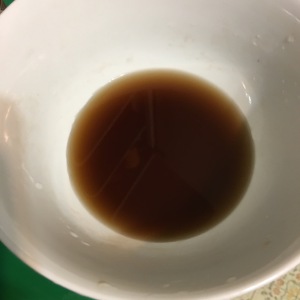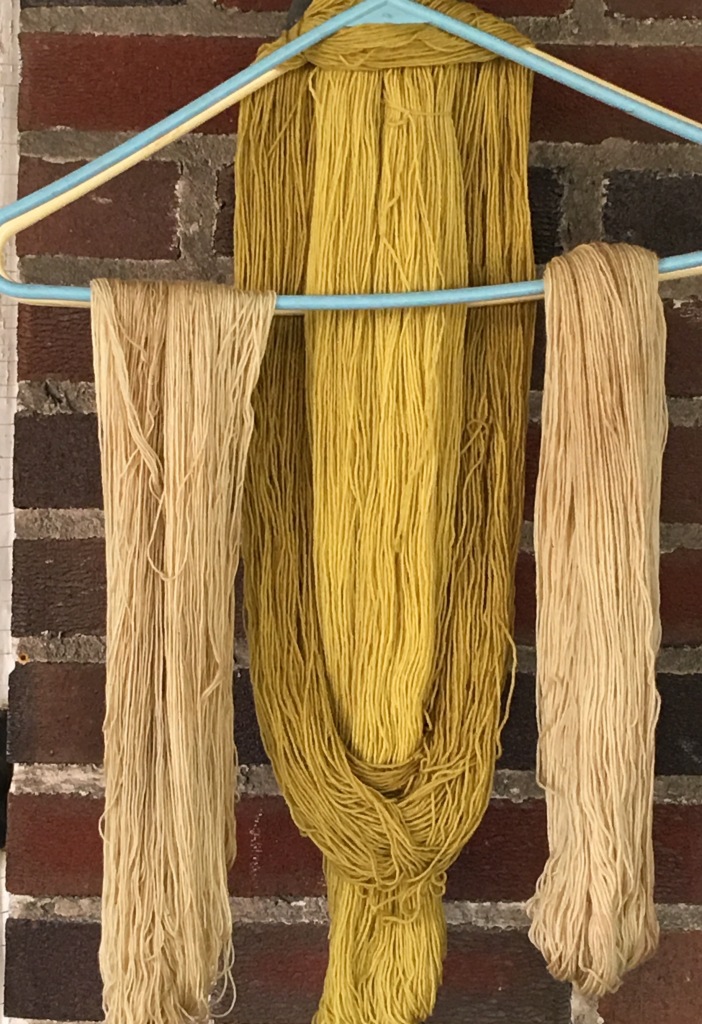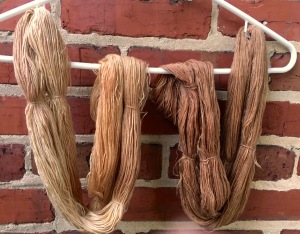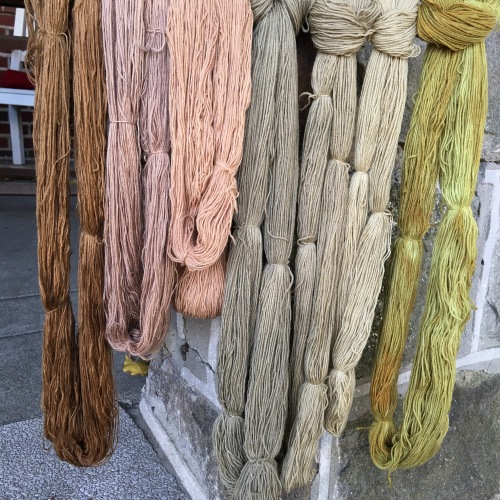I have a collection of Wollmeise lace yarn that is several times beyond SABLE, a useful acronym in knitting jargon that breaks out to “Stash Acquisition Beyond Life Expectancy.” I use this yarn exclusively by choice and necessity, since I have so much that I can’t consider buying other kinds of yarn. I love Wollmeise because of the brand’s vast color palette, but vast as the palette is, there’s a yawning gap in its lack of pale and muted shades. I’ve been lamenting this deficiency for years, and I finally started to do something about it this fall, around the time when I started noticing the walnuts in their green hulls, like small tennis balls, falling to the ground during my daily walks.
I borrowed The Handbook of Natural Plant Dyes by Sasha Duerr from the library and began googling specific plants that I encounter, in order to see the colors people have produced using them, and then I started bringing bags with me on my walks for foraging. Foraging is a very appealing concept to me because it deepens my connection to the places from which the plants came. I also love the fact that items we toss into the garbage are capable of producing a range of colors that are missing from the Wollmeise palette, and the idea of making something beautiful from things I’d been discarding excites my impulses to discover hidden superpowers in ordinary things.
The first thing I foraged was a dozen or so of those tennis-ball-like walnuts, which were fresh and green and hard, and stained my hands yellow and brown when I worked to pry the hulls off the nuts with the nail-pulling end of a hammer. I put the hulls into a cardboard box because I had seen warnings that they would mold if I stored them in a plastic bag, and then I put the box aside while the hulls dried and while I embarked on dyeing that used plants that I thought might be more perishable. First up: marigolds and fig leaves from my sister’s garden in Philadelphia.

Making dinner is a lot more complicated than dyeing yarn. First I prepared an alum mordant: 1 1/2 teaspoons each of alum and cream of tartar (both of which can be found in the baking ingredients aisle of the supermarket) dissolved in some boiling water, and placed in a stainless steel dye pot with enough water to cover 4 ounces of wool yarn that has been soaking in water for at least an hour. Simmer the yarn in the alum mordant for an hour, turn off the heat, and let the yarn soak in the mordant overnight. I had three 300 gram/11 ounce skeins of undyed Wollmeise lace yarn, which was very nice to work with because it’s a superwash yarn that won’t felt if the water is boiling too energetically and won’t disintegrate in an iron mordant. It’s possible to dye yarn without a mordant, but the colors are stronger and more colorfast with a mordant. And if you don’t like a result, you can change the color by throwing the yarn into a different mordant after dyeing.
My original plan for the fig leaves and marigolds my sister gave me was to extract the dye from them as separate baths. But when I weighed my bag of leaves and blossoms, I discovered that I should have picked twice as much of each plant as I did. I needed 4 ounces each to dye 4 ounces of fiber, and in total I had 4.35 ounces. So I chopped them up together, put them into a cheesecloth bag for making soup stock, and simmered the leaves and blossoms in enough water to cover the yarn when I got to that point in the process, and cooked the leaves and blossoms until they looked thoroughly drained of color. After the dye bath cooled, I added my alum-mordanted 4 ounces of yarn to the liquid and simmered them in it, one for a longer time than the other, and this was what I got:

I was thrilled! First time out and I got these two related but distinctly different beautiful greens! It was so exciting to know pretty much nothing and have no skills or experience in this endeavor and nevertheless get something wonderful. This doesn’t happen to me very often. What else could I get?
The book I was using said that dandelion root would give reds. Trust but verify, and Google searches threw that claim into doubt, but I did see something that said that an alum pre-mordant could result in magenta. There is some dandelion species in Scotland that will produce reds, according to the internet, but that seems to be a unicorn sighting. On the other hand, I saw something on Ravelry that said that red-veined dandelion leaves and roots could produce red. I was curious and decided to try it. I went out to the park with a trowel and dug up dandelions until I wore a hole in the skin on the palm of my hand, then chopped them up and cooked the hell out of them.

I got a dye bath that looked like weak coffee.

This is the result:

That’s OK. Beige may not be glamorous, but I didn’t have any beige and I can use it. And I like it with the marigold/fig leaf greens. And I had and have no expectations and can use any color that emerges because I believe that there are no bad colors, just bad ways to use them.
What colors would marigold and fig leaf produce as separate dye baths? I started looking at the marigolds in people’s gardens with a covetous eye, sort of wishing I were the type of person who steals things. But the universe wanted me to have marigolds the honest way. I went out walking in a nearby formal garden and my timing was perfect– they had just pulled out the marigold flower beds, and hundreds of bright yellow marigolds were lying in piles on the ground waiting to be collected and thrown away. So I beheaded as many as I had time to take and made a dye bath out of them. I had about 9 ounces, more than twice the usual recipe of a 1:1 ratio of plant material to fiber, and my first skein from that bath came out a blinding yellow within a few seconds of being in the dye, without heat. I left a second skein in longer to get a darker gradient. I got a lot of use out of that marigold bath– a couple of lighter shades, and brightening for some greens that I made with fig leaves and mint and simmered afterward in a cast iron skillet as an iron after-mordant.


On the left, skeins dyed in fig leaf and simmered afterward in an iron skillet.
On the right, the same skeins after an over-dye in marigold exhaust bath.
The fig leaf dye came from a tree growing in a neighbor’s yard. I noticed it as I was walking by, so I rang the doorbell and asked I could take some of the leaves. Permission was granted, and the leaves, using yarn pre-treated with an alum mordant, produced a yellow with an ochre tinge when the bath was at full strength and a buttery yellow when the bath was a bit less potent. I put the first fig leaf skeins into the cast iron skillet for some simmering and it turned a grayish olive green. I threw those skeins into the marigold bath and got a bit of a golden glow in the resulting color. Those skeins are on the right in the photo below, next to the beige dandelion root skeins. The fig leaf butter-yellow skein is to the left of the fig leaf and marigold skeins in the center of the photo.

The book I was using as my main reference mentioned that pinks and reds and oranges could be gotten from avocado skins and pits. I googled avocado dye and got this article. I accumulated the skins and pits of four avocados and made the liquor the article described by chopping the pits and skins, adding a liter or water and a quarter cup of ammonia, and setting it outside in the sun for a few days to perform whatever chemical processes happen with avocado skins and pits, water, ammonia, heat and light, and time. We were having a bit of a heat wave at the time, and I started worrying that the dye bath might start molding if I let it sit there in the heat, which the article said would produce a brown dye, so I used it after four days of marinating in its juices. Here’s the dye bath just before I used it.

And here’s what  I got. Two intensities of pink-tinged brown, after simmering the light one for a shorter time than the dark one and letting the dark one stay in the bath as it cooled overnight. I think I got the brown because my refrigerator wasn’t working well while I was collecting my pits and skins, and they may have molded a bit. That’s not a disappointment because these are pretty browns and I can use them. All colors have their place.
I got. Two intensities of pink-tinged brown, after simmering the light one for a shorter time than the dark one and letting the dark one stay in the bath as it cooled overnight. I think I got the brown because my refrigerator wasn’t working well while I was collecting my pits and skins, and they may have molded a bit. That’s not a disappointment because these are pretty browns and I can use them. All colors have their place.
And here’s what remained of the dye bath after these two skeins.
 I still have gaps in my yarn palette in the range of pale and muted reds, oranges, and pinks, so I want to have another go at dyeing with avocado, and I’m going to do things differently. Lessons learned for next time: Use much more plant material than I had the first time, which came to about 4 ounces for 4 ounces of fiber, the usual 1:1 ratio. Also give the dye liquor more time to brew, more days sitting out on the porch on the south side of my house, shaking it several times a day to aerate it. Let the fiber spend more time in the dye bath, days, maybe a week, instead of just overnight. And put the skins and pits into the freezer so that they stay fresh. I have a bag of chopped avocado pits and skin in the freezer now, and I think I’ll make separate dye baths of them, because the skins are supposed to produce red/pink hues and the skins yield orange hues.
I still have gaps in my yarn palette in the range of pale and muted reds, oranges, and pinks, so I want to have another go at dyeing with avocado, and I’m going to do things differently. Lessons learned for next time: Use much more plant material than I had the first time, which came to about 4 ounces for 4 ounces of fiber, the usual 1:1 ratio. Also give the dye liquor more time to brew, more days sitting out on the porch on the south side of my house, shaking it several times a day to aerate it. Let the fiber spend more time in the dye bath, days, maybe a week, instead of just overnight. And put the skins and pits into the freezer so that they stay fresh. I have a bag of chopped avocado pits and skin in the freezer now, and I think I’ll make separate dye baths of them, because the skins are supposed to produce red/pink hues and the skins yield orange hues.
Meanwhile, I was haunting the onion bins at my local supermarket in search of onion skins, where the produce department guys told me I was free to grab whatever skins I could scrape together from the bottom of the bins. Onion skins don’t weigh much, so it took a lot of visits to the onion bins to get the 4 ounces I was seeking for the 1:1 ratio of plant material to fiber that has been my rule of thumb. I collected skins from both red onions and yellow onions and mixed them together in the same cheesecloth bag, with some difficulty, because even though they don’t weigh much, they take up a lot of room. It turned out to be a potent dye bath. I dyed 10 ounces of yarn in onion skin, and it was all stunningly beautiful, with mixtures of golden brown to spring green in each skein. I like to keep the cheesecloth bag of plant materials in my dye baths, to get some extra potency, and when the yarn was in contact with the cheesecloth bag with the onion skins, it took on variations of russet brown amid the shades of green.



At this point I had 21 skeins of different, or slightly different, colors. They are greens, yellows, and browns, which are the common colors of natural dyeing. I’m not looking for a wide range of natural colors if it means that I need to buy plants or dye extracts that aren’t local, since I already have a lot of colors of purchased yarn. What’s interesting to me in these dyeing experiments is finding out what’s inside the plants I see every day, plants I wouldn’t even notice if I was unaware that they could be used in dyeing, or plants I just unthinkingly throw away. It gives another dimension to the “looking and noticing” that I try to practice in my walks and through my textile work. I have trouble verbalizing this, but seeing familiar things in an unfamiliar way makes me feel like I have discovered some tiny secret about life. I get that sense of discovery from the color combinations and mathematical questions I answer in my knitting designs. The tag line of my blog “Unlocking the secrets of the universe one knitting project at a time” sounds flippant but I really mean it. I just don’t know how to verbalize it without sounding like an ass.
I wasn’t ready to close the chapter on this series of dyeing experiments with local plants and plant waste until I did something with the walnut hulls I had put aside a month earlier. But when I opened the cardboard shoe box in which they were supposed to dry, I discovered that they had molded into little more than a pile of dust. It was late in the season, but I knew there were some left that hadn’t rotted or been hidden away by the squirrels. I went out for a walk in the park on the day after the U.S. election when the weather was as bleak as I was feeling. My stomach was a knot of nausea as I contemplated a terrible future. The eternal beauty of nature, as I walked through the woods, should have been comforting, but neither eternity, beauty, or nature can be taken for granted when power over the world’s economy and environment is in the hands of people who reject the validity of the evidence and methods of science and denigrate the integrity of scientists whose findings hurt a penny-wise-and-pound-foolish bottom line. I found the last of the green-hulled walnuts, which would be gone in a week, and put them into my bag. I continued my walk, feeling nauseated by my emotional state, and then the fresh citron and furniture polish smell of the walnuts wafted up to my nose from the bag– and the nauseated knot in my stomach suddenly relaxed! I was still in despair, but the physical symptoms of despair were relieved. I thanked the walnut tree for this gift of aromatherapy along with everything else it so generously gives. Meanwhile, my mental soundtrack played Leonard Cohen intoning “take the only tree that’s left, and stuff it up the hole in your culture.” This line was no longer merely figurative.
But along with the aptly grim descriptions and predictions in Leonard Cohen’s lyrics is this one hopeful prescription: Love’s the only engine of survival. So in the spirit of love and survival, I will close with this:
I can’t run no more
with that lawless crowd
while the killers in high places
say their prayers out loud.
But they’ve summoned, they’ve summoned up
a thundercloud
and they’re going to hear from me.
They will indeed. Rest in peace, Leonard.


Wow! You take fresh walnuts, compost materials, and wool and knit them together into a commentary on the state of the world and a view on the universe. Kudos.
I wonder whether invasive like garlic mustard and kudzu would make good dyes.
LikeLike
Thanks, Judy! Good question, I’ll google garlic mustard dye and kudzu dye. There might be a use for those nuisances yet!
LikeLike
According to my good friend Google, garlic mustard will produce a yellow dye and kudzu will produce green.
LikeLike
I love how all the fall colors came out so pretty
LikeLike
I’m very gratified to see that my marigolds and fig leaves produced such loveliness in their afterlife. I wonder if different colors of marigolds produce different colors of dye?
LikeLike
I’m looking forward to finding out when I dye with the orange and brown blossoms you have dried for me.
LikeLike
Fascinating stuff! There has been a recent discussion about walnut dye in the Bohus Stickning Forum on Ravelry. Here is the link to part of this discussion. There is a bit more about it in the preceding and following posts.
http://www.ravelry.com/discuss/bohus-stickning/3516908/26-50#32
It is also interesting that we feed the marigold leaves to our chickens to naturally intensify their egg yoke color!
LikeLike
It never would have occurred to me to use marigolds that way!
LikeLike
I love the deep marigold yellows. They all look fabulous!
LikeLike
Thank you, Michelle! Marigold is amazing.
LikeLike
wow, fantastic colors ! Isn’t dyeing the most magical thing to do?
LikeLike
It certainly is! Magical is the word for it.
LikeLiked by 1 person